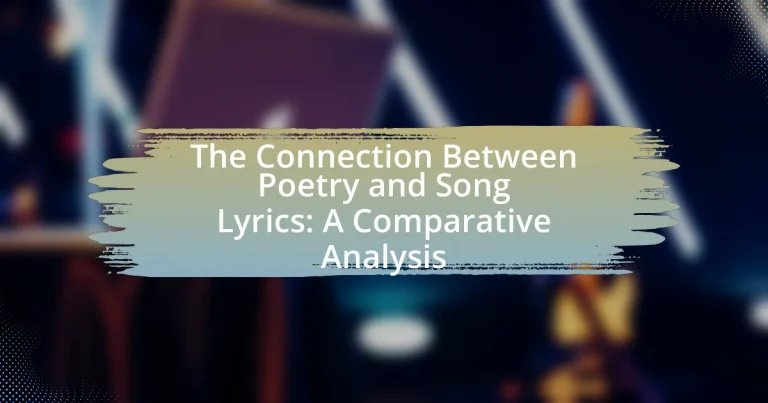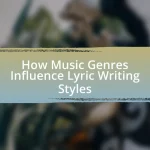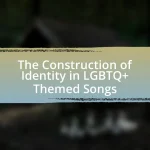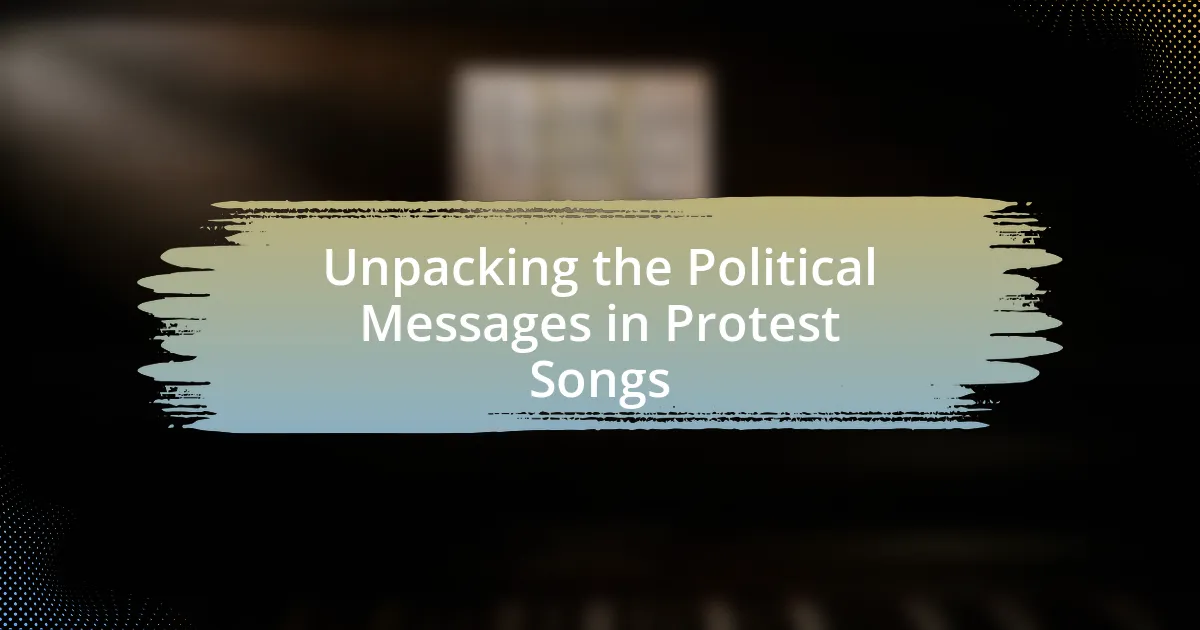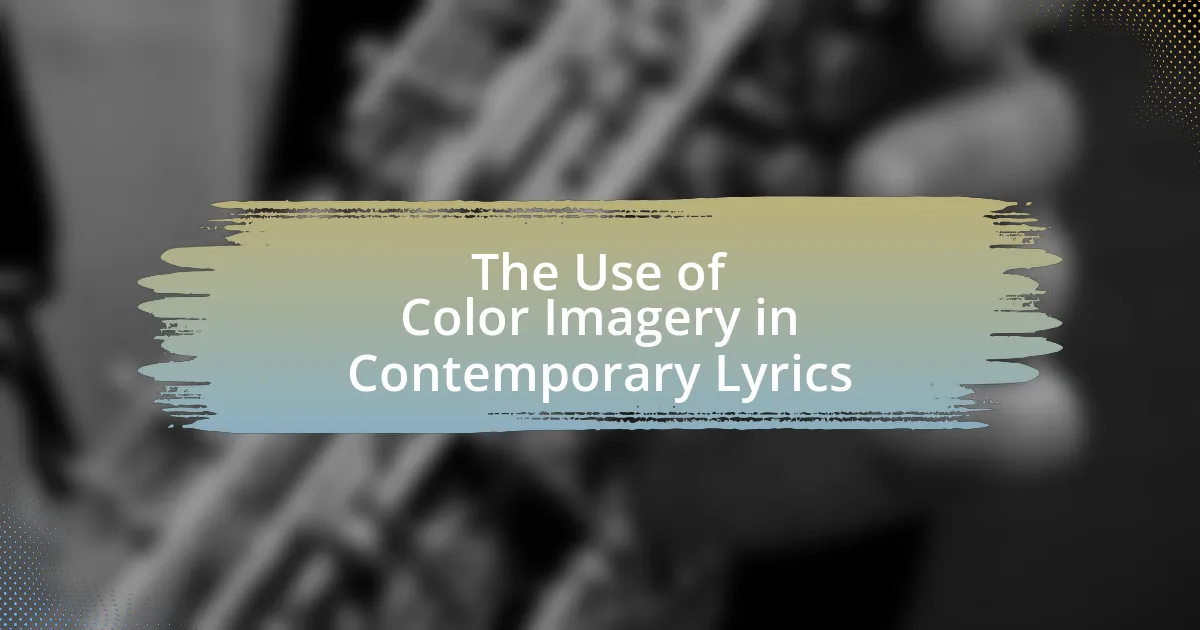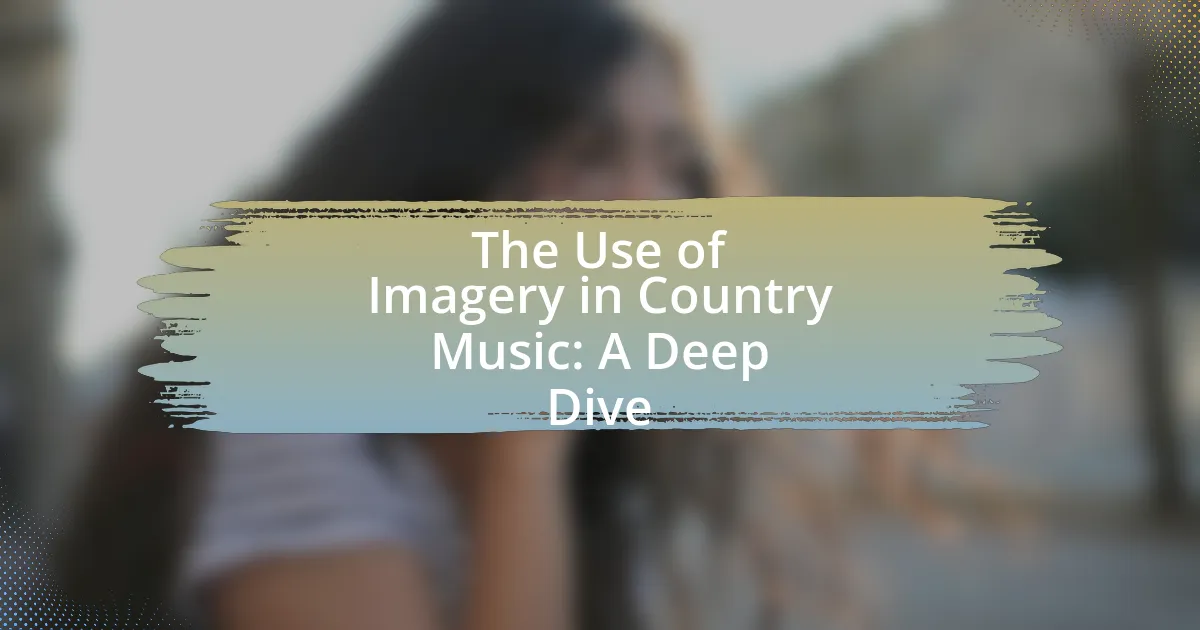The article examines the intrinsic connection between poetry and song lyrics, highlighting their shared use of rhythm, meter, and emotional expression. It explores common elements such as imagery, metaphor, and rhyme, which enhance the impact of both forms. The discussion includes the historical context that shaped their relationship, the influence of different cultures, and notable examples illustrating the evolution of poetry into song lyrics. Additionally, it addresses the challenges faced by poets and songwriters, the differences in audience engagement, and practical tips for incorporating poetic techniques into songwriting. Overall, the article provides a comprehensive analysis of how these two art forms intersect and influence cultural expression.
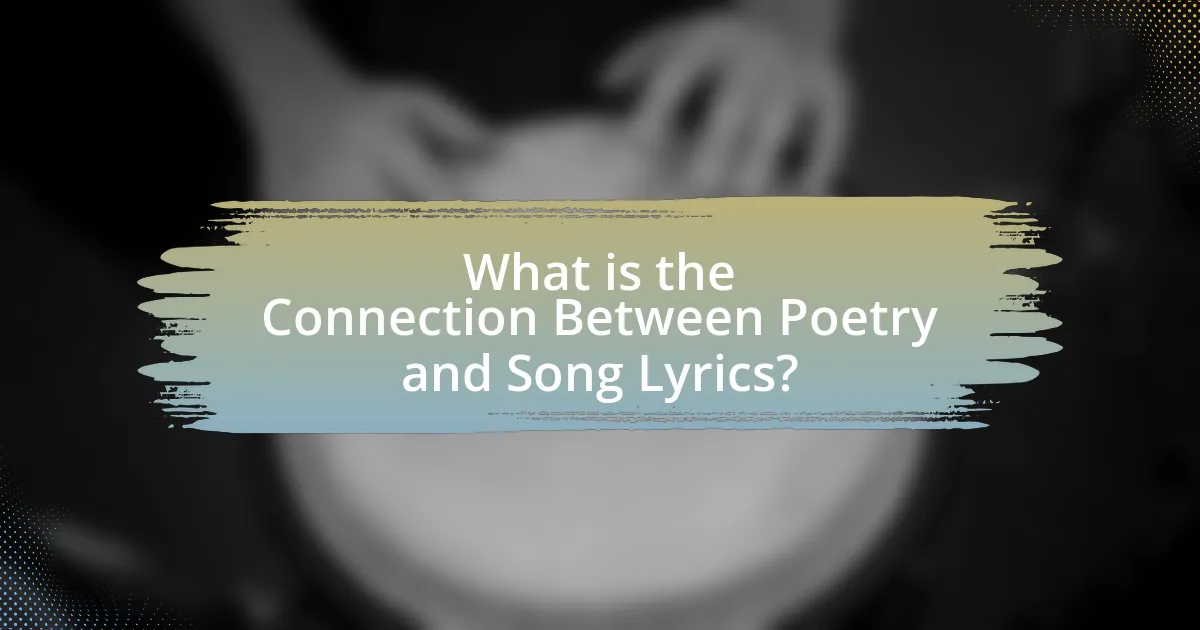
What is the Connection Between Poetry and Song Lyrics?
Poetry and song lyrics share a fundamental connection through their use of rhythm, meter, and emotional expression. Both forms utilize structured language to evoke feelings and convey messages, often employing literary devices such as metaphor, simile, and imagery. For instance, many song lyrics are crafted with a poetic structure, featuring verses and choruses that mirror the stanzas of poetry. Additionally, the historical roots of song lyrics can be traced back to oral traditions where poetry was sung, highlighting their intertwined evolution. This relationship is evident in genres like folk and hip-hop, where lyrical content often reflects poetic themes and styles.
How do poetry and song lyrics share common elements?
Poetry and song lyrics share common elements through their use of rhythm, imagery, and emotional expression. Both forms utilize structured patterns of sound and meter to create a musical quality, enhancing the overall experience for the audience. For instance, many poems employ rhyme schemes and meter similar to those found in song lyrics, which often follow a verse-chorus structure that emphasizes repetition and melody. Additionally, both poetry and song lyrics rely heavily on vivid imagery and metaphor to convey complex emotions and ideas, allowing for deep personal connections with the audience. This is evident in the works of artists like Bob Dylan and poets like Sylvia Plath, who both use rich imagery to evoke feelings and paint pictures in the minds of their listeners or readers.
What literary devices are prevalent in both poetry and song lyrics?
Imagery, metaphor, and rhyme are prevalent literary devices in both poetry and song lyrics. Imagery creates vivid mental pictures, enhancing emotional connection; for example, in both forms, descriptive language evokes sensory experiences. Metaphor allows for deeper meaning by comparing unlike things, enriching the text’s emotional and thematic layers. Rhyme contributes to the musicality and rhythm, making the content more memorable and engaging. These devices are foundational in both poetry and song lyrics, as they enhance expression and resonance with audiences.
How do themes in poetry reflect those in song lyrics?
Themes in poetry often reflect those in song lyrics through shared emotional expressions, narrative structures, and cultural commentary. Both forms utilize metaphor, imagery, and rhythm to convey feelings and experiences, allowing for a deep exploration of universal themes such as love, loss, and identity. For instance, the theme of love is prevalent in both poetry and popular songs, with poets like Pablo Neruda expressing romantic longing similarly to songwriters like Ed Sheeran. This parallel demonstrates how both mediums draw from similar emotional wells and cultural contexts, reinforcing the idea that poetry and song lyrics are interconnected artistic expressions.
Why is the connection between poetry and song lyrics significant?
The connection between poetry and song lyrics is significant because both forms utilize rhythm, meter, and imagery to evoke emotions and convey messages. This shared structure allows for a deeper exploration of themes such as love, loss, and identity, making them relatable across cultures and generations. For instance, renowned poets like Robert Frost and songwriters like Bob Dylan both employ metaphor and symbolism, demonstrating how lyrical content can transcend traditional boundaries of literature and music. This interplay enriches the artistic landscape, fostering a greater appreciation for both mediums.
How does this connection influence cultural expression?
The connection between poetry and song lyrics significantly influences cultural expression by providing a shared medium for storytelling and emotional resonance. This relationship allows for the exploration of themes such as love, loss, and identity, which are prevalent in both forms. For instance, the use of metaphor and rhythm in both poetry and song lyrics enhances the emotional impact, making cultural narratives more relatable and accessible. Historical examples include the Harlem Renaissance, where poets like Langston Hughes influenced the lyrical content of jazz and blues, thereby shaping cultural identity and expression in African American communities. This interplay not only enriches artistic expression but also fosters a deeper understanding of cultural experiences across different societies.
What role does emotion play in both forms of art?
Emotion serves as a fundamental driving force in both poetry and song lyrics, shaping their themes and enhancing their impact on audiences. In poetry, emotion is often conveyed through imagery, metaphor, and rhythm, allowing readers to connect deeply with the poet’s experiences and feelings. Similarly, song lyrics utilize melody and harmony to amplify emotional expression, creating a visceral experience that resonates with listeners. Research indicates that emotional engagement in music can activate brain regions associated with pleasure and reward, highlighting the profound effect of emotion in both art forms. This interplay of emotion not only enriches the artistic experience but also fosters a shared understanding between the creator and the audience.
What historical context shapes the relationship between poetry and song lyrics?
The historical context that shapes the relationship between poetry and song lyrics is rooted in their shared origins in oral traditions and cultural storytelling. Both forms emerged as means of expression in ancient societies, where poetry often served as a precursor to song, utilizing rhythm and meter to enhance memorability and emotional impact. For instance, the epic poems of ancient civilizations, such as Homer’s “Iliad” and “Odyssey,” were recited with musical accompaniment, illustrating the intertwined nature of these art forms. Additionally, the evolution of language and music throughout history, including the development of musical notation in the Middle Ages, further solidified the connection, as poets began to write lyrics specifically designed for musical performance. This historical interplay has led to a continuous exchange of techniques and themes between poetry and song lyrics, reinforcing their relationship across cultures and eras.
How have different cultures influenced this connection over time?
Different cultures have significantly influenced the connection between poetry and song lyrics over time by shaping themes, styles, and forms. For instance, the oral traditions of African cultures have contributed rhythmic patterns and storytelling techniques that are prevalent in contemporary music genres like hip-hop and R&B. Similarly, the influence of Eastern poetic forms, such as the haiku from Japan, has inspired Western songwriters to adopt brevity and imagery in their lyrics. Historical interactions, such as the Silk Road trade, facilitated the exchange of poetic ideas between cultures, leading to hybrid forms that blend diverse musical and lyrical elements. This cross-cultural exchange has enriched both poetry and song lyrics, allowing them to evolve and resonate with broader audiences.
What notable examples illustrate the evolution of poetry into song lyrics?
Notable examples illustrating the evolution of poetry into song lyrics include Bob Dylan’s “Blowin’ in the Wind,” which draws on traditional folk themes and poetic devices, and Leonard Cohen’s “Hallelujah,” known for its rich imagery and emotional depth. Bob Dylan’s work, particularly during the 1960s, transformed social and political commentary into lyrical form, reflecting the poetic tradition of using verse to convey profound messages. Similarly, Leonard Cohen’s integration of literary techniques, such as metaphor and symbolism, showcases how song lyrics can embody the essence of poetry. These examples highlight the seamless transition from poetic expression to musical composition, demonstrating the enduring relationship between the two art forms.
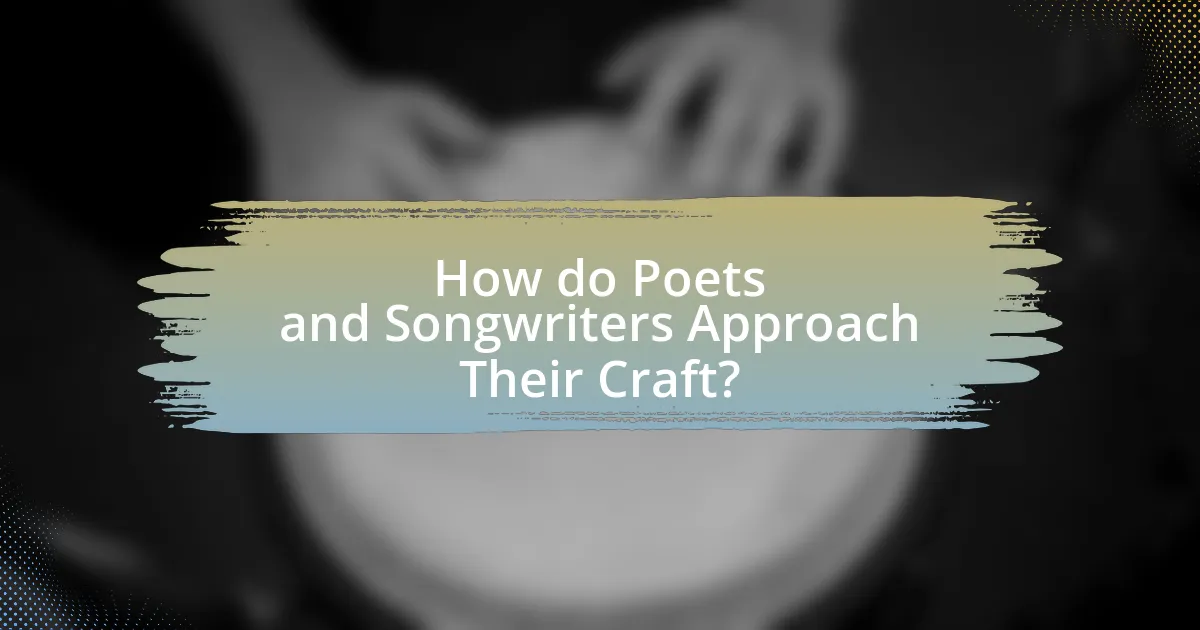
How do Poets and Songwriters Approach Their Craft?
Poets and songwriters approach their craft by employing language, rhythm, and emotion to convey their messages. Both utilize literary devices such as metaphor, imagery, and symbolism to evoke feelings and create vivid experiences for their audience. For instance, poets often focus on the structure and form of their work, while songwriters may prioritize melody and lyrical flow, yet both aim to connect deeply with listeners. This connection is evident in the way renowned poets like Robert Frost and songwriters like Bob Dylan draw from personal experiences and societal themes, illustrating the shared techniques and intentions behind their art forms.
What techniques do poets use that are also found in songwriting?
Poets and songwriters both utilize techniques such as imagery, metaphor, rhyme, and rhythm to convey emotions and tell stories. Imagery allows both forms to create vivid pictures in the audience’s mind, enhancing emotional impact. Metaphors serve as powerful tools for expressing complex ideas succinctly, making abstract concepts relatable. Rhyme contributes to the musicality of both poetry and song lyrics, aiding memorability and engagement. Rhythm, which governs the flow of words, is essential in both mediums, influencing how the audience experiences the text. These shared techniques highlight the intrinsic connection between poetry and songwriting, demonstrating their overlapping artistic foundations.
How does rhythm and meter play a role in both poetry and song lyrics?
Rhythm and meter are fundamental elements in both poetry and song lyrics, shaping their structure and emotional impact. In poetry, rhythm refers to the pattern of sounds and silences, while meter is the specific arrangement of stressed and unstressed syllables, creating a musical quality that enhances the reading experience. Similarly, in song lyrics, rhythm dictates the flow of words in relation to the melody, and meter establishes a consistent beat that guides the listener’s engagement.
For instance, many traditional forms of poetry, such as sonnets, adhere to strict metrical patterns, like iambic pentameter, which creates a predictable rhythm that can evoke specific emotions. In songs, artists often use varying rhythms and meters to complement the musical composition, as seen in genres like hip-hop, where syncopation and varied meter can create a dynamic listening experience. The interplay of rhythm and meter in both forms not only aids memorization but also enhances the overall aesthetic, making the content more impactful and resonant with audiences.
What is the importance of imagery in both forms of expression?
Imagery is crucial in both poetry and song lyrics as it evokes sensory experiences and emotions, enhancing the audience’s connection to the work. In poetry, imagery creates vivid mental pictures that allow readers to engage deeply with themes and emotions, as seen in works like William Wordsworth’s “I Wandered Lonely as a Cloud,” where the imagery of daffodils conveys feelings of joy and nostalgia. Similarly, in song lyrics, artists like Bob Dylan use imagery to paint scenes that resonate with listeners, such as in “Blowin’ in the Wind,” where visual elements provoke thought and reflection. This shared reliance on imagery in both forms of expression underscores its importance in conveying complex emotions and ideas effectively.
How do the audiences for poetry and song lyrics differ?
Audiences for poetry and song lyrics differ primarily in their engagement and consumption methods. Poetry audiences often seek deeper literary analysis and emotional resonance, appreciating the nuances of language and structure, while song lyrics audiences typically focus on melody and rhythm, valuing the overall musical experience. Research indicates that poetry readers are more likely to engage in solitary reading and reflection, whereas song listeners often experience music in social settings, enhancing communal enjoyment. This distinction highlights the varying contexts in which each form is appreciated, with poetry often associated with introspection and song lyrics linked to entertainment and shared experiences.
What factors influence audience engagement in poetry versus song lyrics?
Audience engagement in poetry versus song lyrics is influenced by factors such as emotional resonance, accessibility, and performance context. Emotional resonance is critical; song lyrics often utilize melody and rhythm to enhance feelings, making them more immediately impactful. In contrast, poetry relies on imagery and language complexity, which can create a deeper but sometimes less accessible emotional experience. Accessibility plays a significant role as well; song lyrics are typically designed for mass consumption and are often simpler, while poetry may require more cognitive engagement and interpretation. Performance context also affects engagement; songs are usually performed live, creating a communal experience, whereas poetry readings may be more intimate and personal. These factors collectively shape how audiences connect with and engage in each form.
How do performance elements affect the reception of poetry and song lyrics?
Performance elements significantly influence the reception of poetry and song lyrics by enhancing emotional engagement and interpretative depth. The delivery style, including vocal tone, rhythm, and physical gestures, shapes how audiences perceive and connect with the content. For instance, a study by the University of California, Berkeley, found that live performances of poetry can evoke stronger emotional responses compared to written forms, as the performer’s expressiveness adds layers of meaning. Similarly, in song lyrics, elements like melody and dynamics can amplify the emotional weight of the words, making them more memorable and impactful. Thus, the integration of performance elements is crucial in shaping audience reception and interpretation of both poetry and song lyrics.
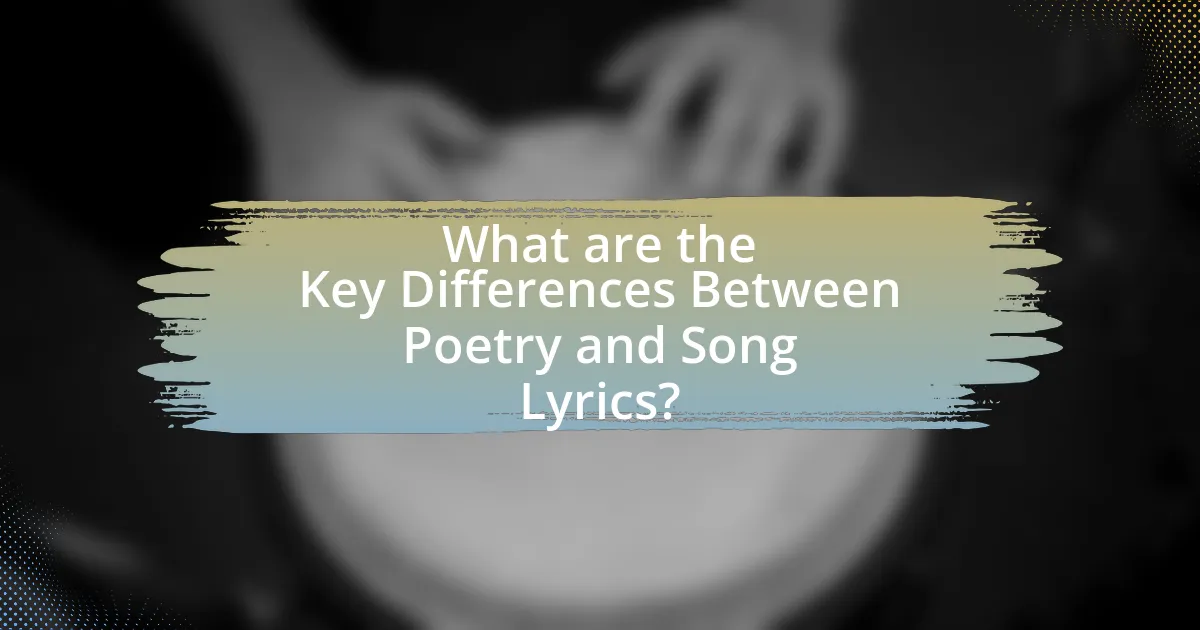
What are the Key Differences Between Poetry and Song Lyrics?
Poetry and song lyrics differ primarily in their intended performance and structure. Poetry is often written for reading and can utilize various forms and styles without the necessity of musical accompaniment, while song lyrics are specifically crafted to be sung and are typically structured to fit a melody, often incorporating repetitive elements like choruses. Additionally, song lyrics frequently prioritize rhythm and rhyme to enhance musicality, whereas poetry may focus more on imagery and emotional depth without the constraints of melody. This distinction is evident in the way song lyrics often rely on hooks and catchy phrases to engage listeners, while poetry may explore complex themes and emotions in a more nuanced manner.
How does structure differ between poetry and song lyrics?
The structure of poetry typically emphasizes form, meter, and line breaks, while song lyrics prioritize rhythm, melody, and repetition. Poetry often adheres to specific forms such as sonnets or haikus, which dictate the number of lines and syllable counts, creating a visual and auditory experience. In contrast, song lyrics are designed to complement musical elements, leading to variations in structure that may include verses, choruses, and bridges, which enhance the overall musicality. This distinction is evident in the way poetry can explore complex themes through varied line lengths and enjambment, whereas song lyrics often utilize hooks and refrains to create memorable and singable phrases.
What are the common formats used in poetry compared to song lyrics?
Common formats used in poetry include stanzas, verses, and various rhyme schemes, while song lyrics typically consist of verses, choruses, and bridges. Poetry often employs structured forms such as sonnets or haikus, which have specific syllable counts and rhyme patterns, whereas song lyrics focus on repetition and melody, allowing for more flexible structures. For instance, a typical song may have a verse-chorus structure that emphasizes the hook, contrasting with poetry’s emphasis on meter and formality. This distinction highlights how both mediums utilize format to convey emotion and meaning, yet they do so through different structural conventions.
How do the purposes of poetry and song lyrics vary?
The purposes of poetry and song lyrics vary primarily in their intended modes of expression and audience engagement. Poetry often aims to evoke deep emotional responses and provoke thought through imagery and metaphor, while song lyrics typically prioritize rhythm and melody, enhancing emotional connection through musicality. For instance, poetry can explore complex themes and abstract ideas, as seen in works by poets like Emily Dickinson, who uses concise language to convey profound emotions. In contrast, song lyrics, such as those by Bob Dylan, often focus on storytelling and relatable experiences, making them accessible and memorable through their musical context. This distinction highlights how poetry leans towards literary exploration, whereas song lyrics emphasize auditory experience and communal enjoyment.
What challenges do poets and songwriters face in their respective fields?
Poets and songwriters face several challenges in their fields, primarily including the struggle for originality, the pressure of audience expectations, and the difficulty of emotional expression. Originality is crucial, as both poets and songwriters must create unique works that stand out in a saturated market; for instance, the National Endowment for the Arts reported that over 40 million Americans engage in creative writing, intensifying competition. Audience expectations add another layer of complexity, as creators often feel compelled to conform to popular trends or commercial viability, which can stifle their authentic voice. Additionally, the challenge of conveying deep emotions in a concise and impactful manner is significant; studies show that emotional resonance is key to audience connection, yet achieving this within the constraints of form can be daunting. These challenges highlight the intricate balance poets and songwriters must maintain between creativity, market demands, and personal expression.
How do commercial pressures affect songwriting compared to poetry?
Commercial pressures significantly influence songwriting by prioritizing marketability and audience appeal, whereas poetry often allows for greater creative freedom and personal expression. In the music industry, songwriters frequently tailor their work to fit commercial trends, aiming for catchy hooks and relatable themes that resonate with listeners, which can lead to formulaic structures. For instance, the Billboard Hot 100 charts often reflect songs that adhere to specific patterns, such as verse-chorus-verse formats, driven by commercial success metrics. In contrast, poets typically have the liberty to explore complex themes and unconventional structures without the same commercial constraints, allowing for deeper artistic exploration. This distinction highlights how commercial pressures shape the creative processes in songwriting more than in poetry.
What barriers exist for poets in gaining recognition compared to songwriters?
Poets face several barriers in gaining recognition compared to songwriters, primarily due to the lack of mainstream platforms and commercial viability. Unlike songwriters, who benefit from the music industry’s extensive promotional networks and radio play, poets often rely on literary publications and readings, which have limited reach. Additionally, the cultural perception of poetry as a niche art form contrasts with the widespread appeal of music, making it harder for poets to attract large audiences. According to a study by the National Endowment for the Arts, only 6.7% of adults in the U.S. read poetry in 2017, highlighting the limited audience compared to the billions of music listeners globally. This disparity in audience size and access to promotional resources significantly hinders poets’ visibility and recognition.
What practical tips can enhance the connection between poetry and song lyrics?
To enhance the connection between poetry and song lyrics, writers should focus on rhythm, imagery, and emotional resonance. Rhythm is crucial as both poetry and song lyrics rely on meter and flow to engage the audience; for instance, many popular songs utilize iambic pentameter, similar to classic poetry. Imagery plays a significant role as well; vivid and evocative language can create strong visual associations, making the lyrics more memorable and impactful, as seen in the works of artists like Bob Dylan and Leonard Cohen, who often employ rich imagery akin to that found in poetry. Lastly, emotional resonance is vital; both forms aim to evoke feelings, and using personal experiences or universal themes can deepen the listener’s connection, as demonstrated by the emotional depth in the lyrics of Adele and the poignant verses of Sylvia Plath.
How can aspiring artists incorporate poetic techniques into their songwriting?
Aspiring artists can incorporate poetic techniques into their songwriting by utilizing devices such as imagery, metaphor, and rhyme. Imagery enhances the emotional impact of lyrics by creating vivid pictures in the listener’s mind, similar to how poets evoke feelings through descriptive language. For example, using metaphors allows artists to convey complex emotions and ideas succinctly, as seen in the works of renowned songwriters like Bob Dylan, who often employs metaphor to deepen meaning. Additionally, incorporating rhyme schemes can create a musical quality in lyrics, making them more memorable and engaging, akin to traditional poetry. This approach not only enriches the lyrical content but also aligns songwriting with established poetic traditions, enhancing the overall artistic expression.
What resources are available for studying the relationship between poetry and song lyrics?
Resources for studying the relationship between poetry and song lyrics include academic journals, books, and online databases. Notable academic journals such as “Poetry” and “The Journal of Popular Music Studies” publish articles that analyze the interplay between these two forms of expression. Books like “Lyrics: A New History of English Poetry” by James Fenton and “The Poetry of Song” by David A. J. Richards provide comprehensive insights into the similarities and differences between poetry and song lyrics. Additionally, online databases such as JSTOR and Project MUSE offer access to scholarly articles and research papers that explore this relationship in depth. These resources collectively support a thorough understanding of how poetry and song lyrics influence and reflect cultural and emotional themes.
